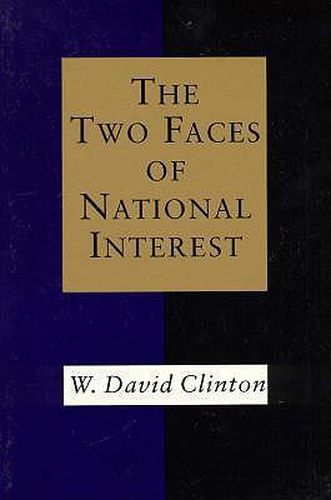Readings Newsletter
Become a Readings Member to make your shopping experience even easier.
Sign in or sign up for free!
You’re not far away from qualifying for FREE standard shipping within Australia
You’ve qualified for FREE standard shipping within Australia
The cart is loading…






In The Two Faces of National Interest, W. David Clinton sets out to form a clear definition of a concept that may have become too elastic for its (and our) own good, and to ascertain its utility in the field of foreign relations.
Much of the confusion surrounding the term National Interest, Clinton argues, stems from the fact that analysts and officials use it in two different senses, without defining it precisely or making clear which sense they mean in any particular case. In Part One of his study, Clinton presents a clarification of the two meanings, one, the common good of a society, which necessarily looks inward to the basic principles of the domestic regime; the other a specific claim, which can be supported by justifying arguments, made by the state on other states or the society of states. Clinton lays out the critics’ case against national interest, suggests that his definition meets the objections, and considers the special case of the fit between national-interest thinking and the American diplomatic tradition.
In Part Two, Clinton uses this definition to consider four departures in American foreign policy, that is, significant turns in policy that occasioned reexamination of the requirements of the national interest, since World War II. The preparation of the Marshall Plan and the decision to enter the Korean War both came during the Truman presidency and together did much to define containment; the evolution of the Nixon Doctrine and the Carter policy on human rights accompanied the end of the containment consensus and marked attempts to devise a new roster of asserted interests. Interpreting these events by means of the society’s national interest and the several national interests or claims pressed by it on the international setting, Clinton concludes that the concept of national interest, if used carefully, remains a valuable tool for understanding international relations.
In presenting a balanced treatment of what is sometimes an extremely controversial subject, Clinton addresses an issue largely ignored since Charles Beard and Hans J. Morgenthau. Written with grace and power, Two Faces of National Interest is an informed, thought-provoking, and authoritative work that will have enduring value as a scholarly and public information resource.
$9.00 standard shipping within Australia
FREE standard shipping within Australia for orders over $100.00
Express & International shipping calculated at checkout
In The Two Faces of National Interest, W. David Clinton sets out to form a clear definition of a concept that may have become too elastic for its (and our) own good, and to ascertain its utility in the field of foreign relations.
Much of the confusion surrounding the term National Interest, Clinton argues, stems from the fact that analysts and officials use it in two different senses, without defining it precisely or making clear which sense they mean in any particular case. In Part One of his study, Clinton presents a clarification of the two meanings, one, the common good of a society, which necessarily looks inward to the basic principles of the domestic regime; the other a specific claim, which can be supported by justifying arguments, made by the state on other states or the society of states. Clinton lays out the critics’ case against national interest, suggests that his definition meets the objections, and considers the special case of the fit between national-interest thinking and the American diplomatic tradition.
In Part Two, Clinton uses this definition to consider four departures in American foreign policy, that is, significant turns in policy that occasioned reexamination of the requirements of the national interest, since World War II. The preparation of the Marshall Plan and the decision to enter the Korean War both came during the Truman presidency and together did much to define containment; the evolution of the Nixon Doctrine and the Carter policy on human rights accompanied the end of the containment consensus and marked attempts to devise a new roster of asserted interests. Interpreting these events by means of the society’s national interest and the several national interests or claims pressed by it on the international setting, Clinton concludes that the concept of national interest, if used carefully, remains a valuable tool for understanding international relations.
In presenting a balanced treatment of what is sometimes an extremely controversial subject, Clinton addresses an issue largely ignored since Charles Beard and Hans J. Morgenthau. Written with grace and power, Two Faces of National Interest is an informed, thought-provoking, and authoritative work that will have enduring value as a scholarly and public information resource.